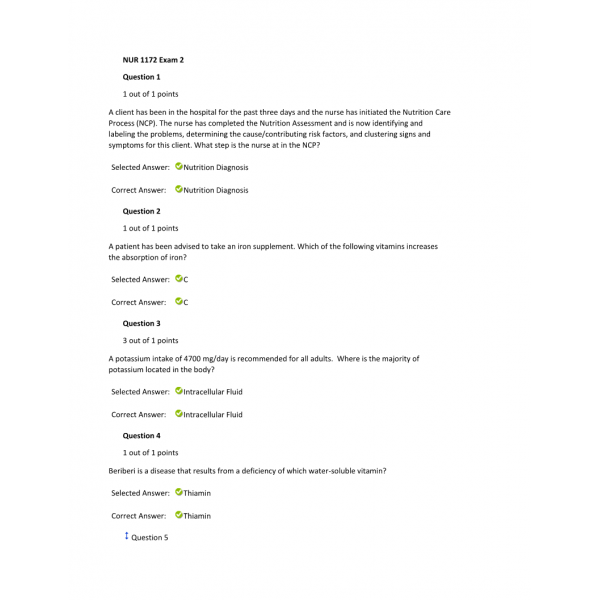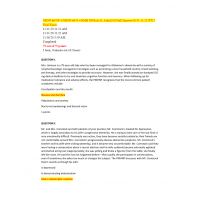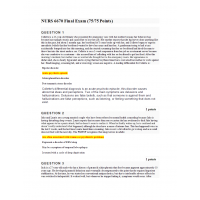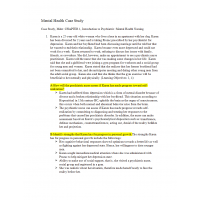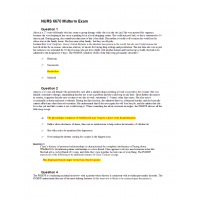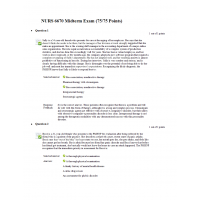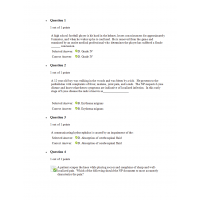NUR 1172 Exam 2 - Nutrition Rasmussen
NUR 1172 Exam 2 - Question and Answers - Rasmussen
- A client has been in the hospital for the past three days and the nurse has initiated the Nutrition Care Process (NCP). The nurse has completed the Nutrition Assessment and is now identifying and labeling the problems, determining the cause/contributing risk factors, and clustering signs and symptoms for this client. What step is the nurse at in the NCP?
- A patient has been advised to take an iron supplement. Which of the following vitamins increases the absorption of iron?
- A potassium intake of 4700 mg/day is recommended for all adults. Where is the majority of potassium located in the body?
- Beriberi is a disease that results from a deficiency of which water-soluble vitamin?
- False claims regarding certain foods, supplements or medicines can be dangerous. What is one of the greatest dangers to individuals practicing unfounded nutritional habits?
- Hormones can influence water balance. Identify two influential hormones that affect the balance of body water.
- In recent years there have been several reports of major food infection outbreaks. Which bacterium causes an infection after the consumption of raw or undercooked ground beef?
- In the acute care setting a nutritional screen is required and must be completed within how many hours following admission?
- Iron plays an important role in which metabolic function?
- Minerals are classified as major minerals and trace elements. Select the item that lists two of the trace elements.
- Most Americans consume more than the recommended 1500 mg of sodium. What is the major source of sodium in the United States?
- Most individuals get the required daily amount (RDA) of Vitamin D from fortified milk and sun exposure. What disease is making a comeback when breastfeed infants do not receive Vitamin D supplements?
- Select the preferred method of providing nutrition to clients in the acute care setting.
- The Dietary Reference Intake (DRI) for calcium increases for which group of individuals over the age of 50?
- The Mini Nutritional Assessment (MNA) is an assessment tool to detect undernutrition for which age group?
- The United States Department of Agriculture is focused on the following areas related to foods and nutrition. Select the correct answer.
- The ability of the eye to adapt to changes in light depends on the light-sensitive pigment, rhodopsin, located in the rods of the retina. Normal rhodopsin cannot be formed when what vitamin is deficient in a person’s diet?
- The nurse is providing a nutrition education program for a client who has a diagnosis of osteoporosis. The nurse can confirm that the client understands the teaching when the client states the following will increase calcium absorption.
- The nurse teaches the client the role of vitamin D. Which statement by the client about vitamin D indicates that the teaching has been effective?
- The term evidence-based practice has become a crucial component of healthcare. What is the FIRST step in this process?
- There are two forces controlling body water distribution. Identify these two forces.
- To be classified as a vitamin, a compound has to meet three (3) criteria. Which of the following is NOT a requirement go be classified as a vitamin?
- Vitamins are classified as fat-soluble or water-soluble. Select the item that lists only fat-soluble vitamins.
- Waist circumference is used to classify overweight and obesity as well as to estimate disease risk. What waist circumference indicates that a client is at risk for disease?
- What are the three functions of nutrients for the body? Select the answer below.
- What do nutritional and medical authorities agree is the optimal single food for an infant during the first 6 to 7 months of life?
- What federal agency is responsible for food health claims, food and drug education, false advertising and the review of food labels?
- What foods would be included on a clear liquid diet?
- What is considered a normal Body Mass Index (BMI)?
- What is the MOST IMPORTANT reason for a nutrition screen to be performed?
- What is the primary defense to prevent contacting or spreading food borne illnesses?
- What is the purpose of performing a nutritional screen on an older adult?
- What is the unit of measurement used by nutritionists to describe the energy content of food?
- What model does the Academy of Nutrition and Dietetics recommend using to provide nutrition care for clients?
- When does the aging process begin?
- When performing a nutrition assessment on an older adult, the nurse asks the client about recent weight loss. Based on the client’s response, the nurse is able to determine that the patient unintentionally has lost 5% of their weight in the last month. What is the relevance of this weight loss?
- When taking a patient’s history for a nutritional assessment, the client states “I do not take any medication. I only take herbal supplements.” What response by the nurse would be appropriate?
- When working with infants, children, and their nutrition, what is the most sensitive indicator of growth and development?
- Which clinical observation is a sign of good nutritional status?
- Which fat-soluble vitamin is associated with the synthesis of blood clotting factors in the liver?
- Which food selection is high in Vitamin E?
- Which government agency is responsible for tracking and reporting the incidence of foodborne illnesses?
- Which of the following is a normal physiologic change that occurs in pregnancy?
- Which of the following is true concerning organic foods?
- Which of the following is true regarding BMI (Body Mass Index)?
- Which of the following personal habits should be discouraged during pregnancy?
- Which of the following will most likely enhance the success of a client’s nutrition therapy?
- Which structure is responsible for providing fetal nourishment?
- Which term refers to the state of dynamic equilibrium within the internal environment of the body resulting in a balance of physiologic metabolism?
Why is it important for a client with a chronic disease to maximize the quality of their nutritional intake?
| Institution & Term/Date | |
| Term/Date | Walden University |
-
$25.00

